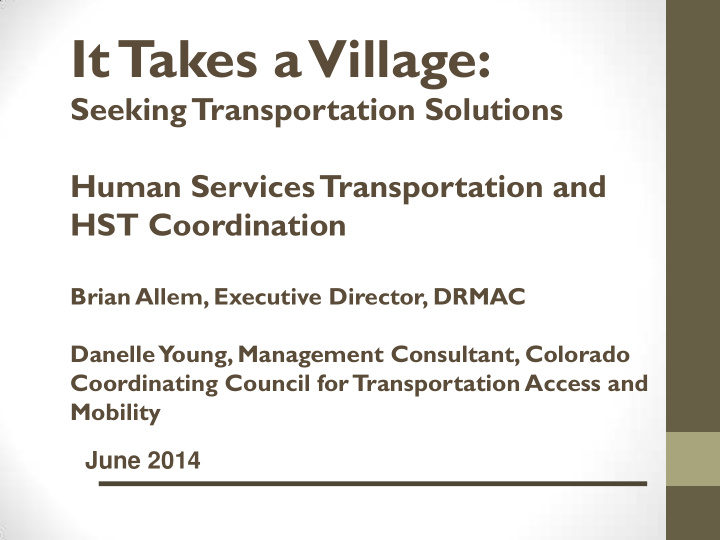



It Takes a Village: Seeking Transportation Solutions Human Services Transportation and HST Coordination Brian Allem, Executive Director, DRMAC Danelle Young, Management Consultant, Colorado Coordinating Council for Transportation Access and Mobility June 2014
Transportation is the key to EVERYTHING: To go anywhere, to have fun, and to get everything you need to live. PHOTO COURTESY OF Via Mobility Services ( 2 )
Things we know: • Transportation is expensive!!! • The need for transportation is increasing • More people • More seniors • More special needs • More low income • Demand exceeds supply • and will do more so in the future • Public funding is allocated away from human services ( 3 ) • Funding is in silos, not person-centered
Need for Transportation Coordination Bringing Together Funding, Service, and Transportation Interests will… • Maximize limited resources • Provide more rides • Make it easier • Reduce duplication • Increase satisfaction ( 4 )
Current Stakeholder Initiatives State Level: State Coordinating Council Regional Level: DRMAC and others Local Level: Local County Coordinating Councils All meeting to work on coordination of services, funding and utilizing available resources ( 5 )
Denver Regional Mobility and Access Council (DRMAC) Regional collaboration at work • Getting There Guide published annually • Also offer an online option for information: database.gettingthereguide.com • Promoting regional transportation coordination through technology by development of an online trip exchange • Daily operation of Transportation Information and Assistance Call Center • Provides individual consultations and informs callers of transportation ( 6 ) resources in the region that most closely fit their specific needs
Governmental Initiatives • Community Living Advisory Group (CLAG) • Function of the Office of Community Living • Created through executive order by Governor Hickenlooper in July 2012 • Housed in the Department of Healthcare Policy and Finance (HCPF) • Purpose is to meet the growing need for long-term services • Supports people with disabilities and aging adults • HCPF Care Coordination Subcommittee • Reports to Community Living Advisory Group • Charged with the following: • Reviewing existing care coordination efforts and programs, and making recommendations regarding how to make care coordination ( 7 ) more effective by working through initiatives such as Colorado Choice Transitions (CCT), the Medicaid Expansion project, Regional Care Collaborative Organization (RCCO) development, etc.
Recommendation #1 Support the development of a coordinated system of transportation in the region. a) Engage with State, Regional, and Local Coordinating Councils b) Give preferential treatment to agencies that collaborate and participate in coordination efforts ( 8 )
Recommendation #1 , continued c) Facilitate connections between transportation providers and transportation users d) Create Incentives at state, regional and local levels for transportation coordination and collaboration Work with Veteran’s Transportation [and other] groups to e) coordinate services Transportation USERS ( 9 ) Transportation PROVIDERS
Recommendation #2 Support simplification a) Work with other agencies to simplify and consolidate reporting requirements ( 10 )
Recommendation #2 Support simplification , continued b) Work to remove overly restrictive and conflicting state agency requirements around funding/service eligibility i. Allow sharing of vehicles, e.g., use and maintenance ii. Encourage other resource-sharing and activities coordination, e.g., driver-sharing, driver safety or customer-sensitivity training, co-op liability insurance, scheduling and/or dispatch systems, voucher systems, etc. iii. Remove barriers that prohibit mixing of ( 11 ) populations, funding sources, and trip purposes
Recommendation #2 (Support simplification , continued ) (Work to remove overly restrictive…requirements…) iv.Work with other agencies to create a unified cost accounting processes and reporting requirements v.Work with state and federal agencies to recognize verified true cost of transportation services and develop strategies for addressing reimbursement rates vi.Develop state agency mechanisms to allow for cost sharing and joint funding where they don’t exist ( 12 )
Recommendation #3 Support innovation in transportation operations a) Work with CDOT and other state agencies to identify potential cost savings through pool operations i. Identify potential savings from pooled purchases for fuel, insurance, vehicles, contracted services (i.e., drug and alcohol testing, safety programs, training, etc.) ii. Identify potential cost savings through technology such as scheduling software, accounting software, ( 13 ) asset management systems, fuel management systems, mobile data technology, etc.
Recommendation #3 (Support innovation , continued ) b) Support the use of technology to enhance customer service i. Support the development of communication tools, i.e., social media, targeted texting, alerts, etc. ii. Support the development and use of One-Call/One-Click services and No-Wrong-Door policies 1) Work with organizations that are moving forward on this, i.e., Veterans Transportation and Community Living Initiative (VTCLI), regional brokerages, etc. 2) Work to integrate human services operations with ( 14 ) transportation operations such as coordination of 511 and 211
Recommendation #3 (Support innovation , continued ) c) Support the use of technology to promote efficiency and productivity d) Work toward a vision of a single, universal transportation pass for all service modes i. Include rail, bus, shuttle, taxi, tolling, parking, B-Cycle, etc. ii. Ensure access by all funding sources iii. Provide for all trip purposes ( 15 )
Recommendation #4 Work toward a collaborative future a) Participate in long- and short-range transportation, economic development and community planning efforts at the state, regional and local areas b) Support innovative service and concepts proven, promising practices ( 16 )
Thank you for your time and attention
Recommend
More recommend